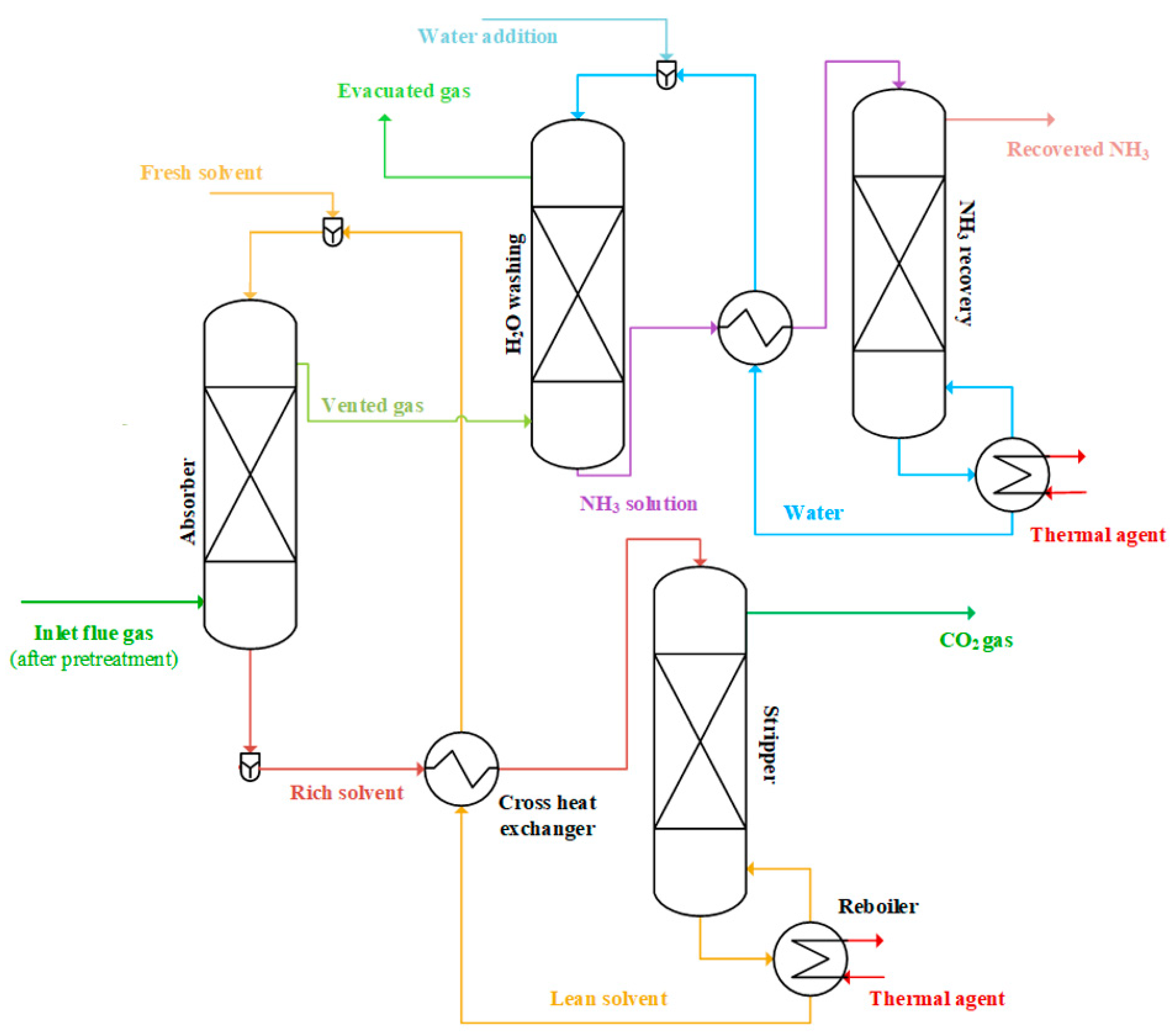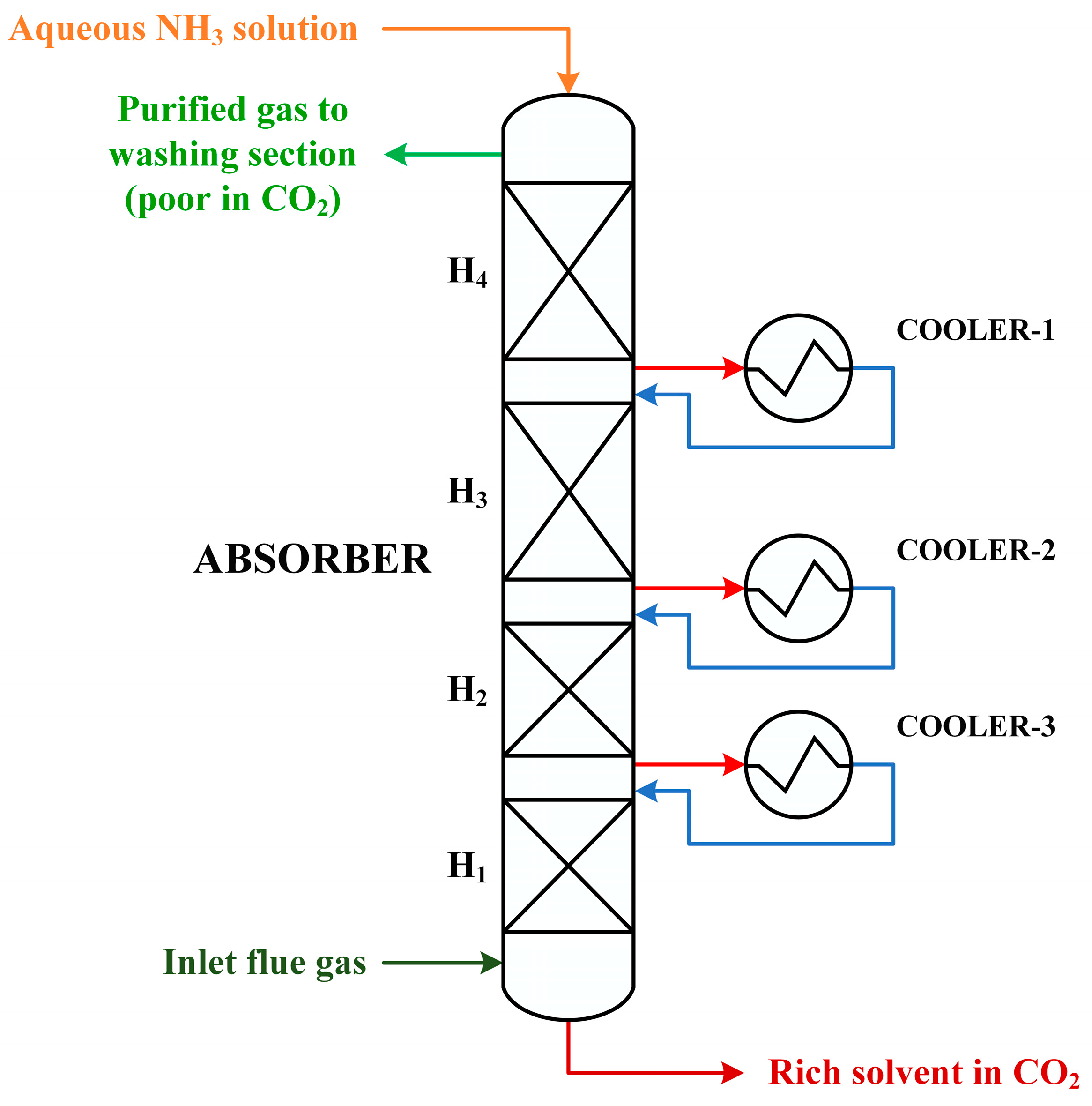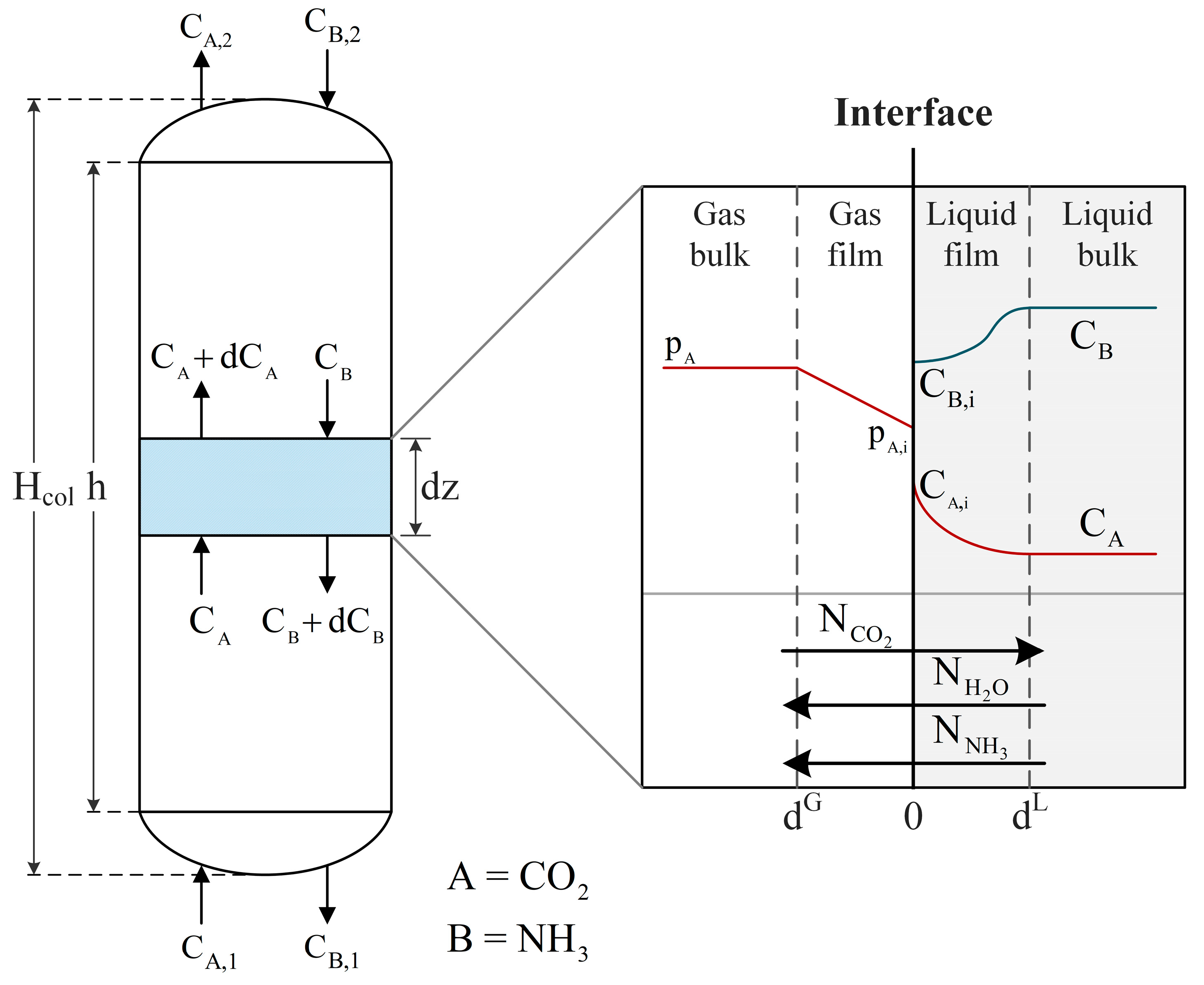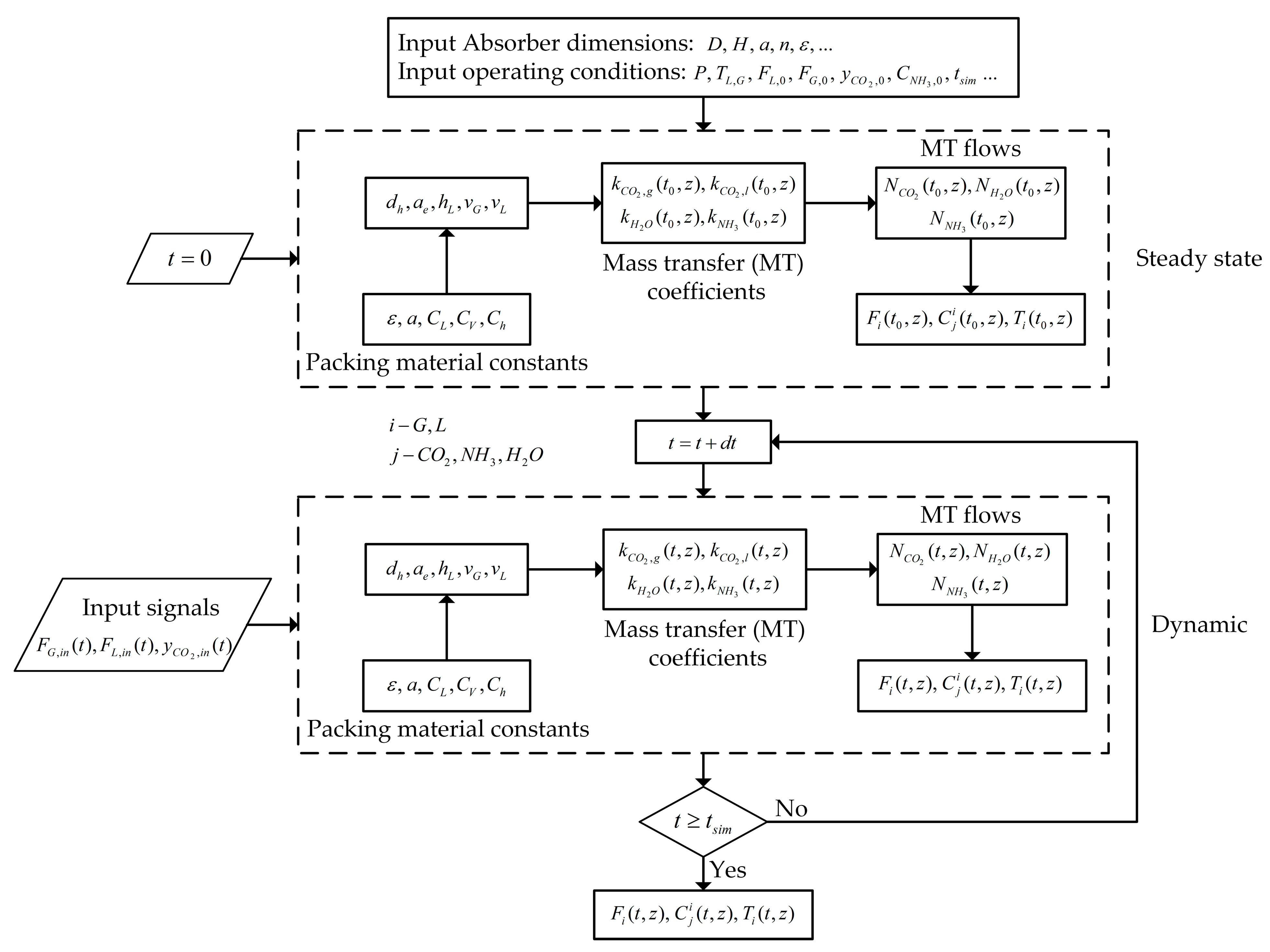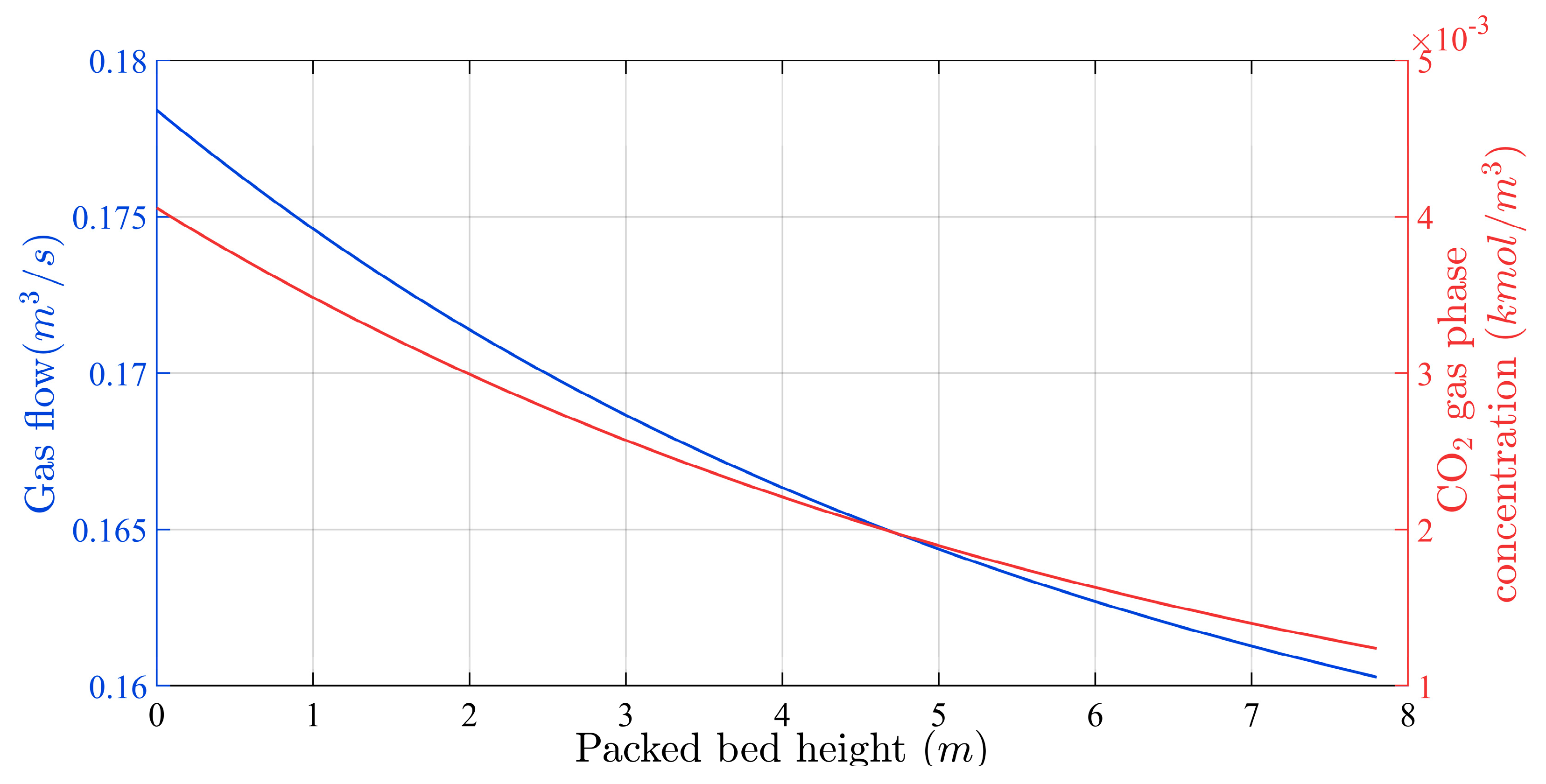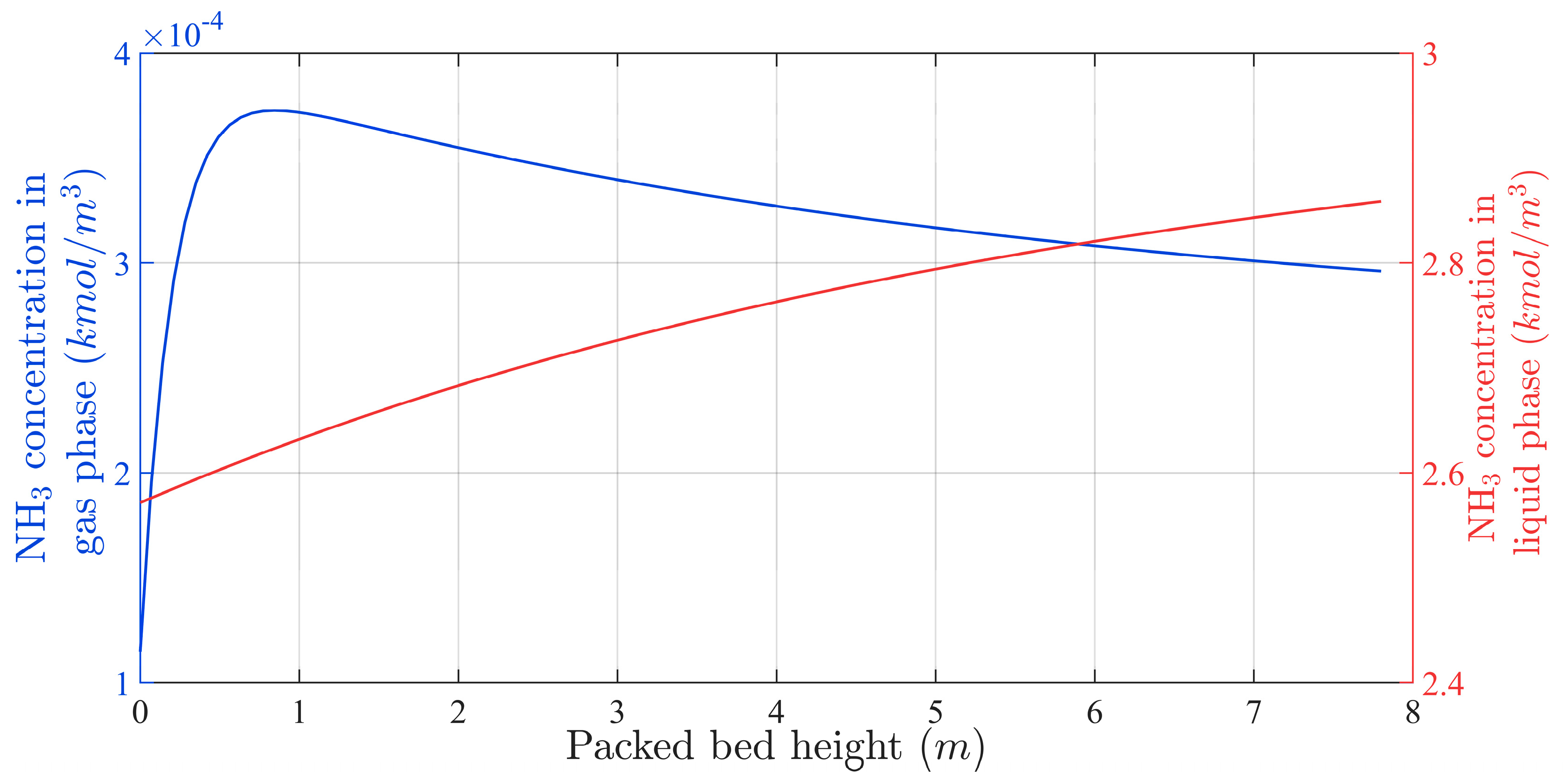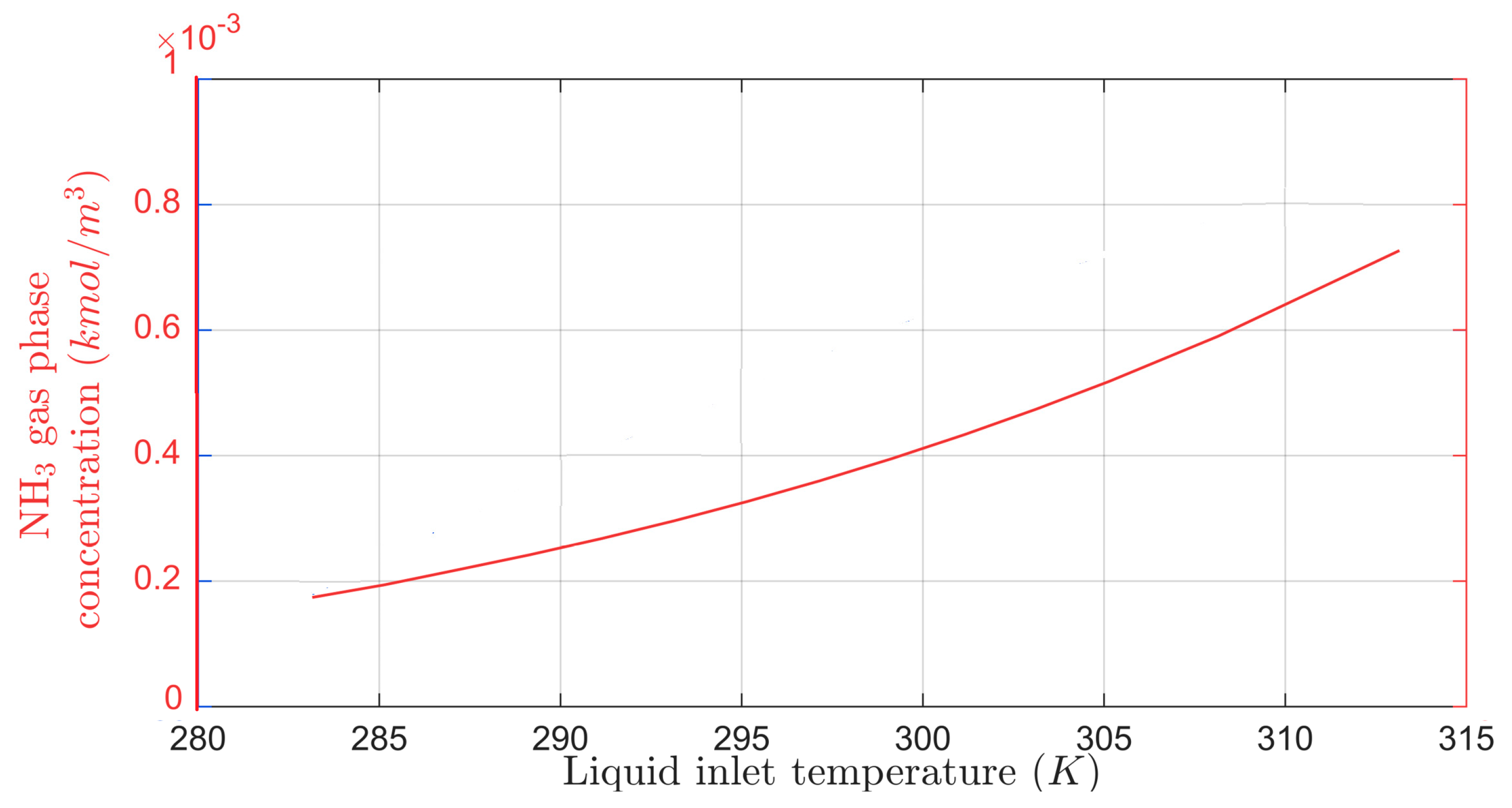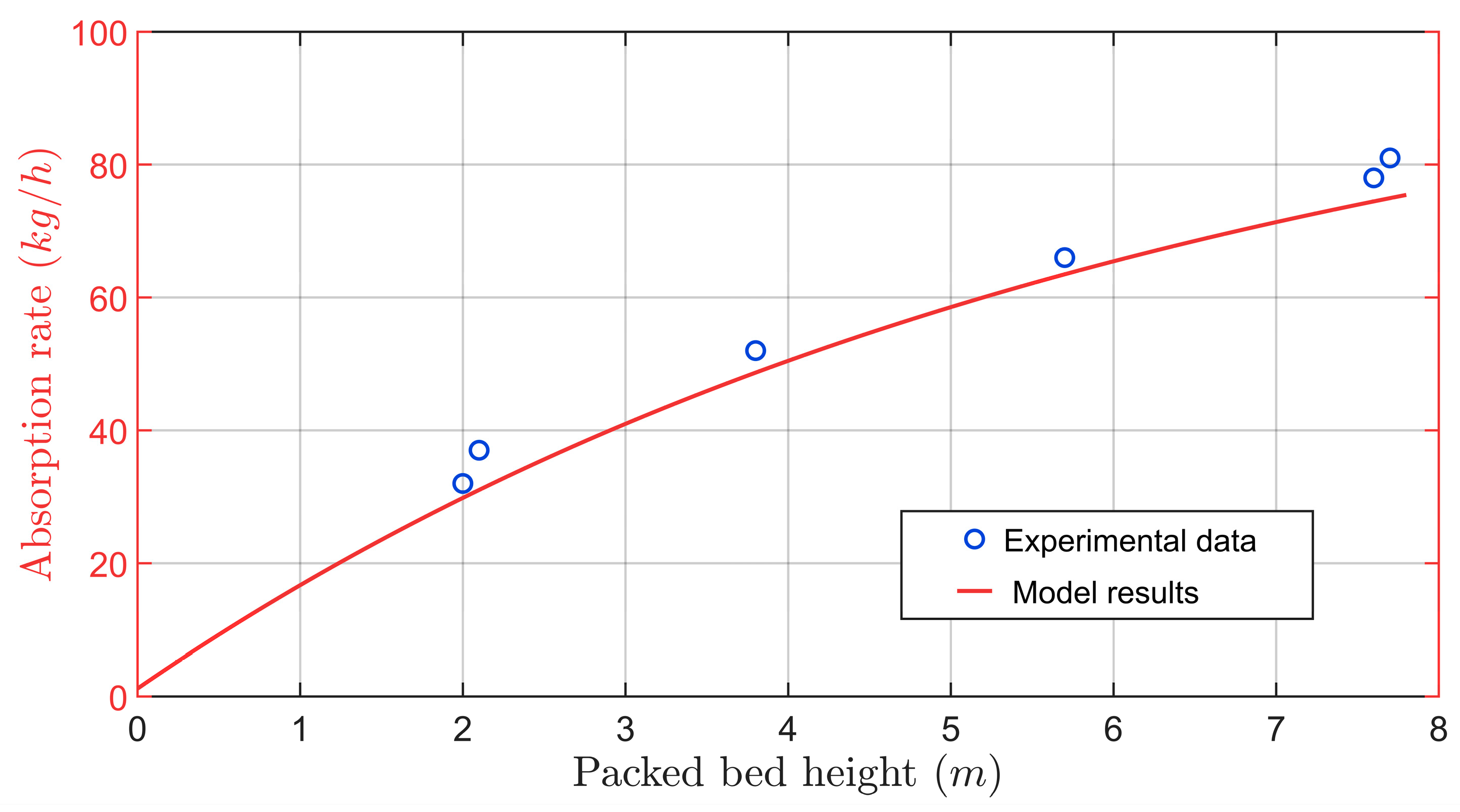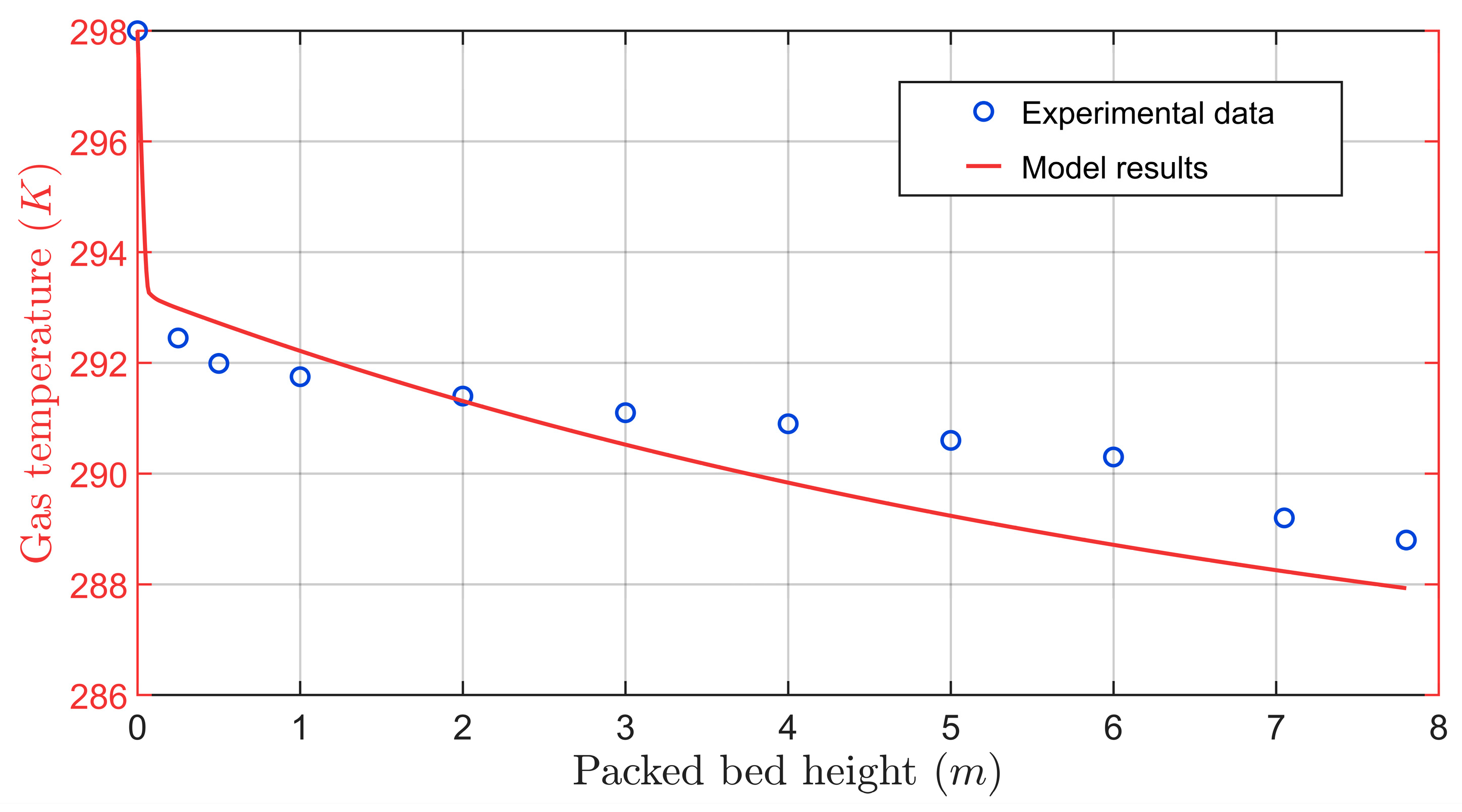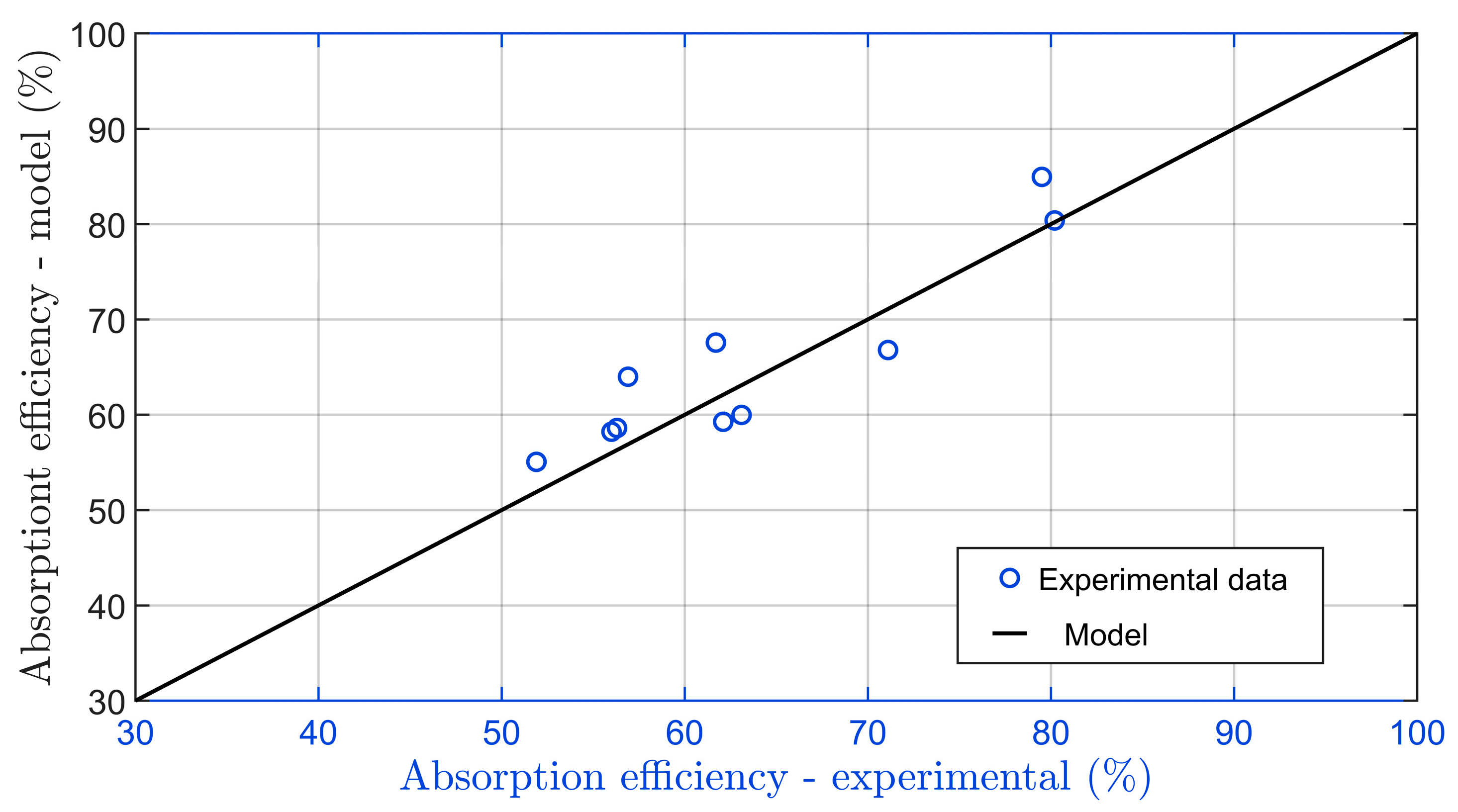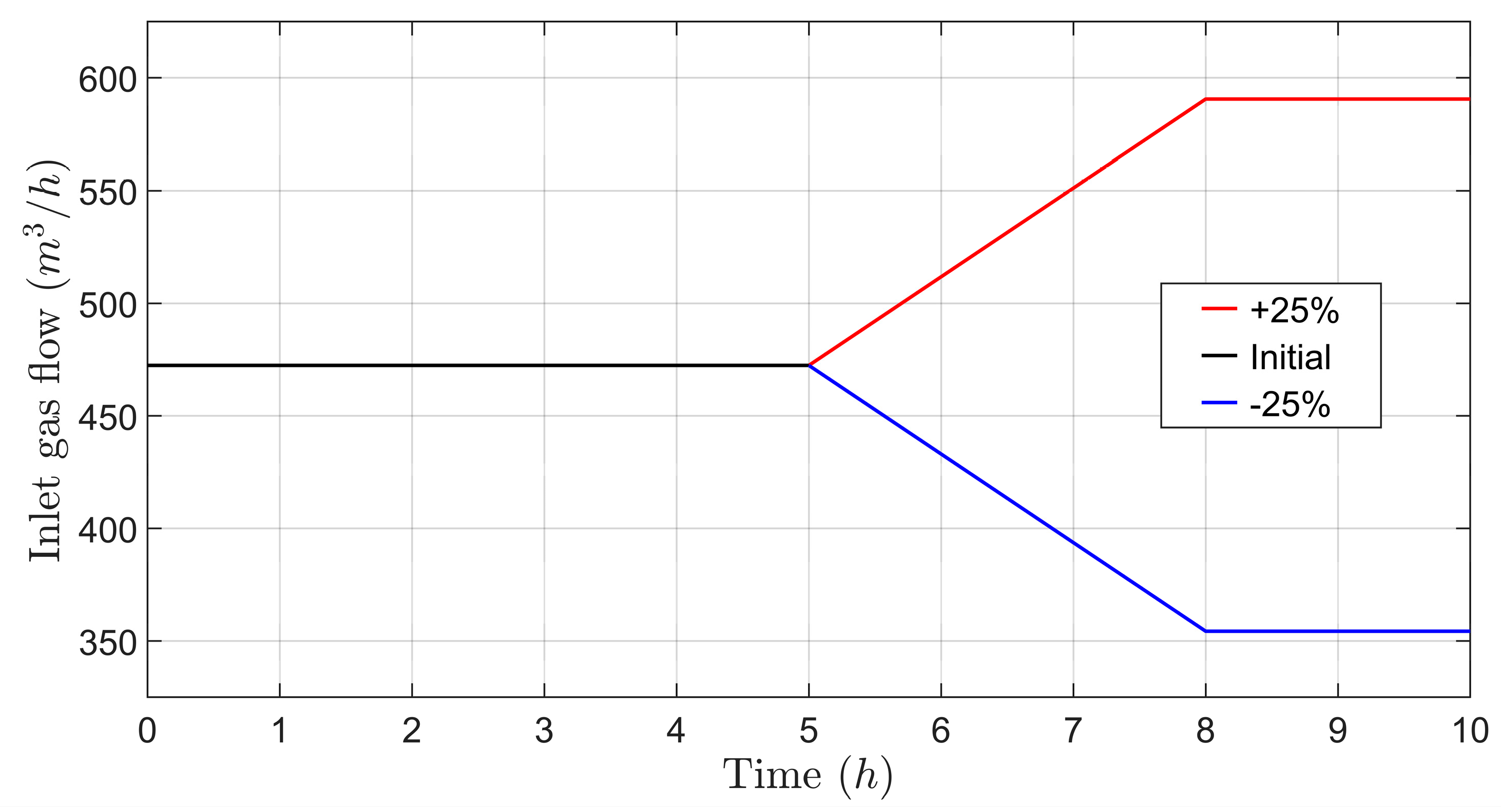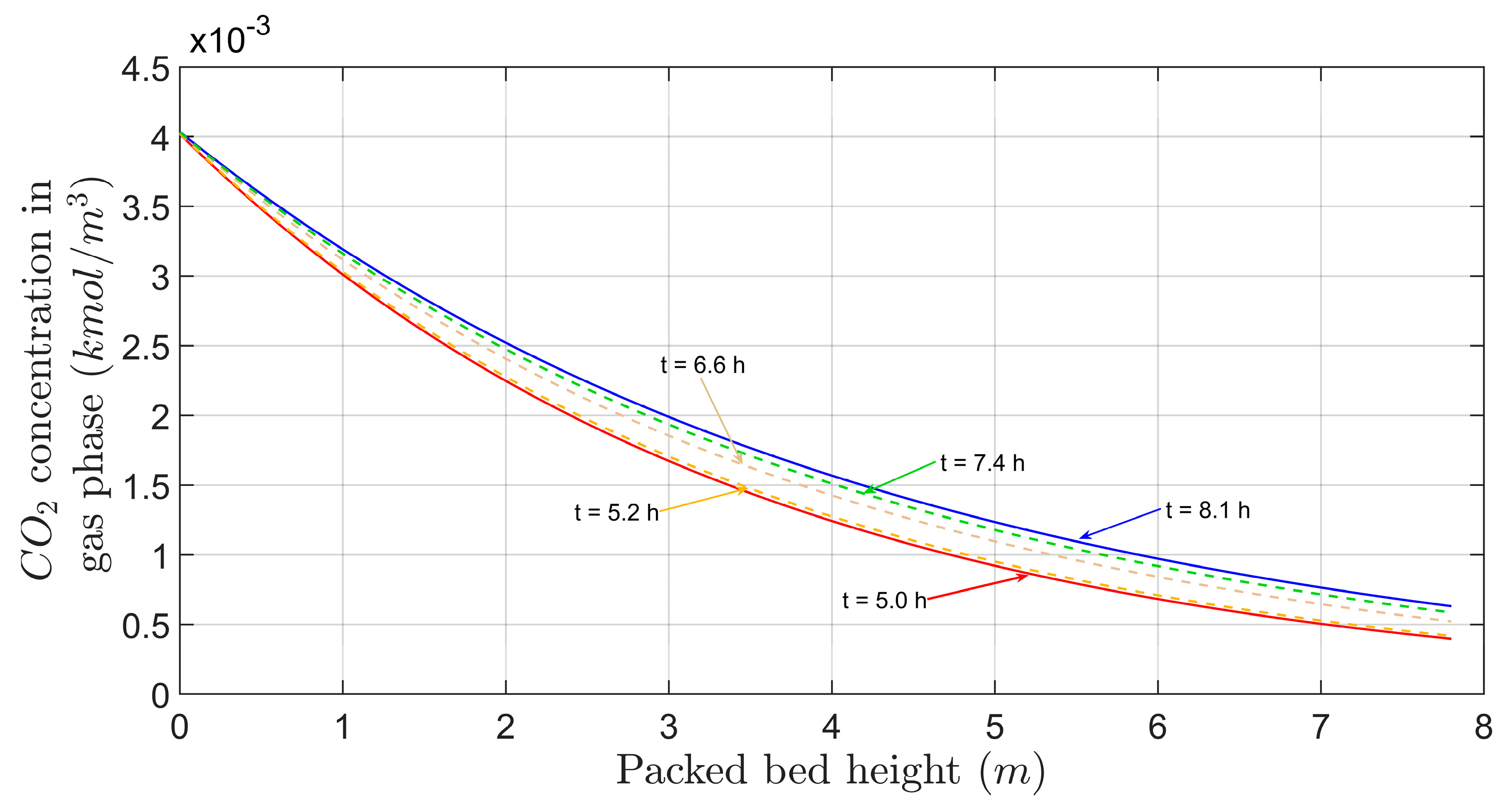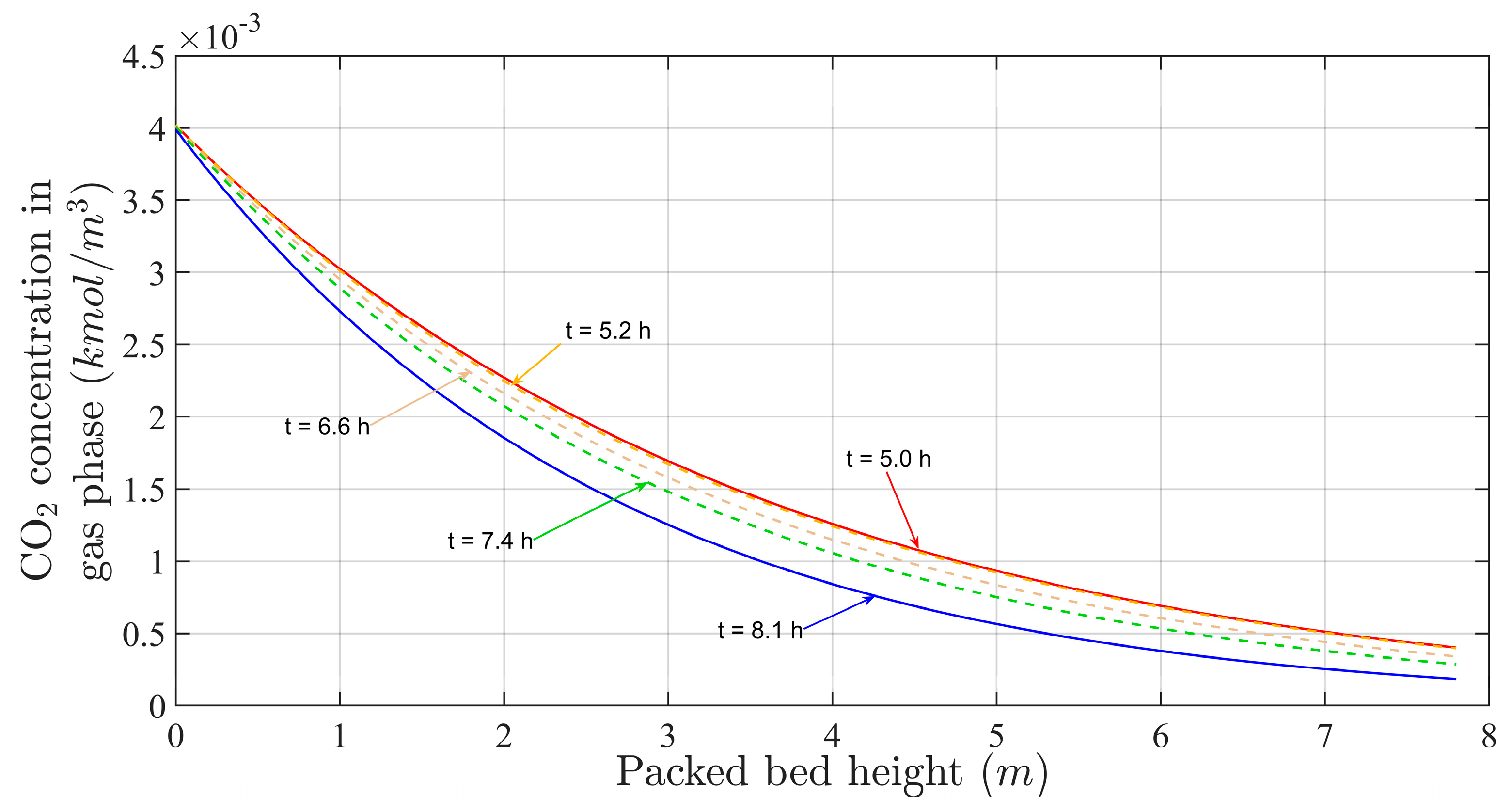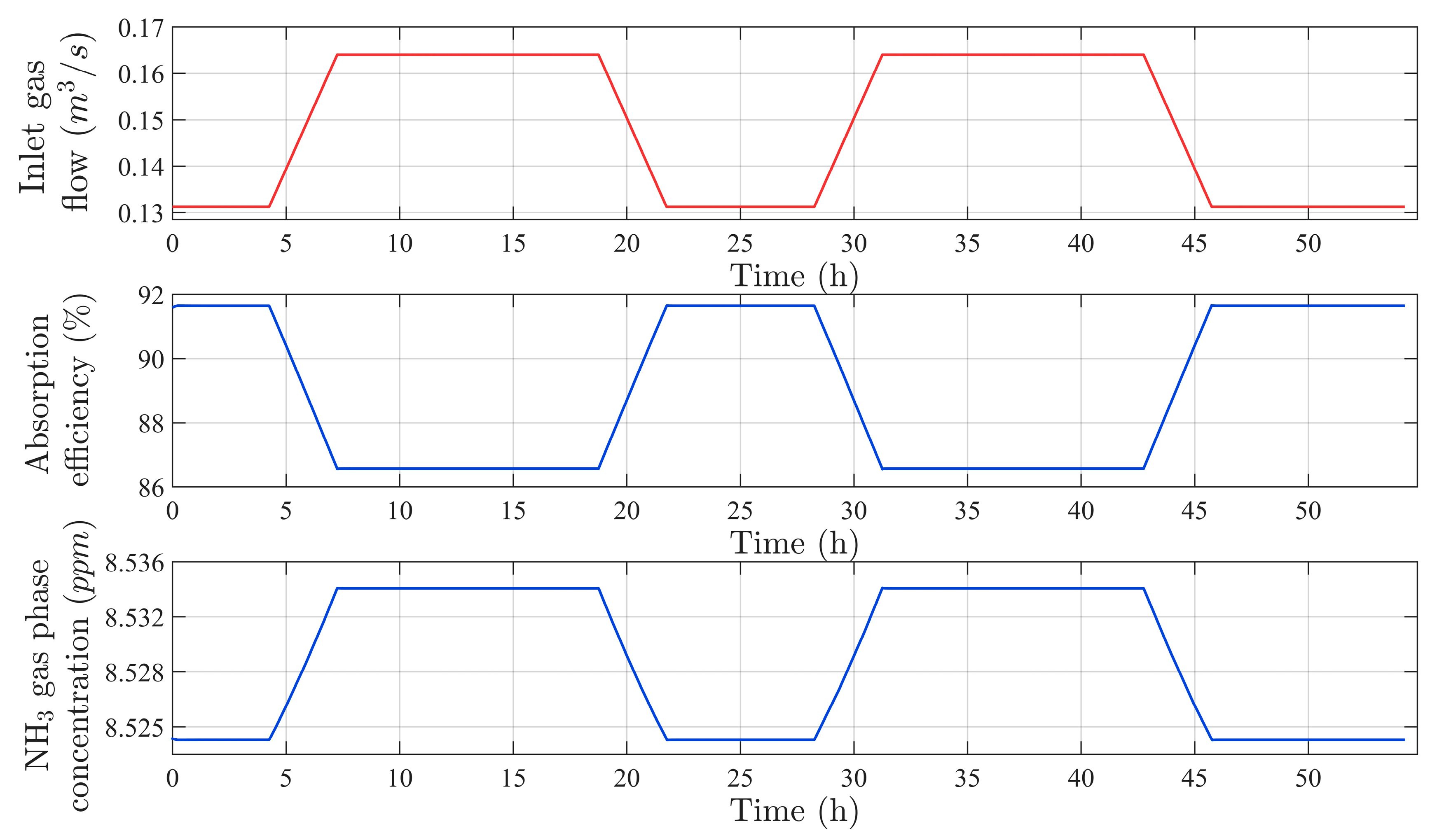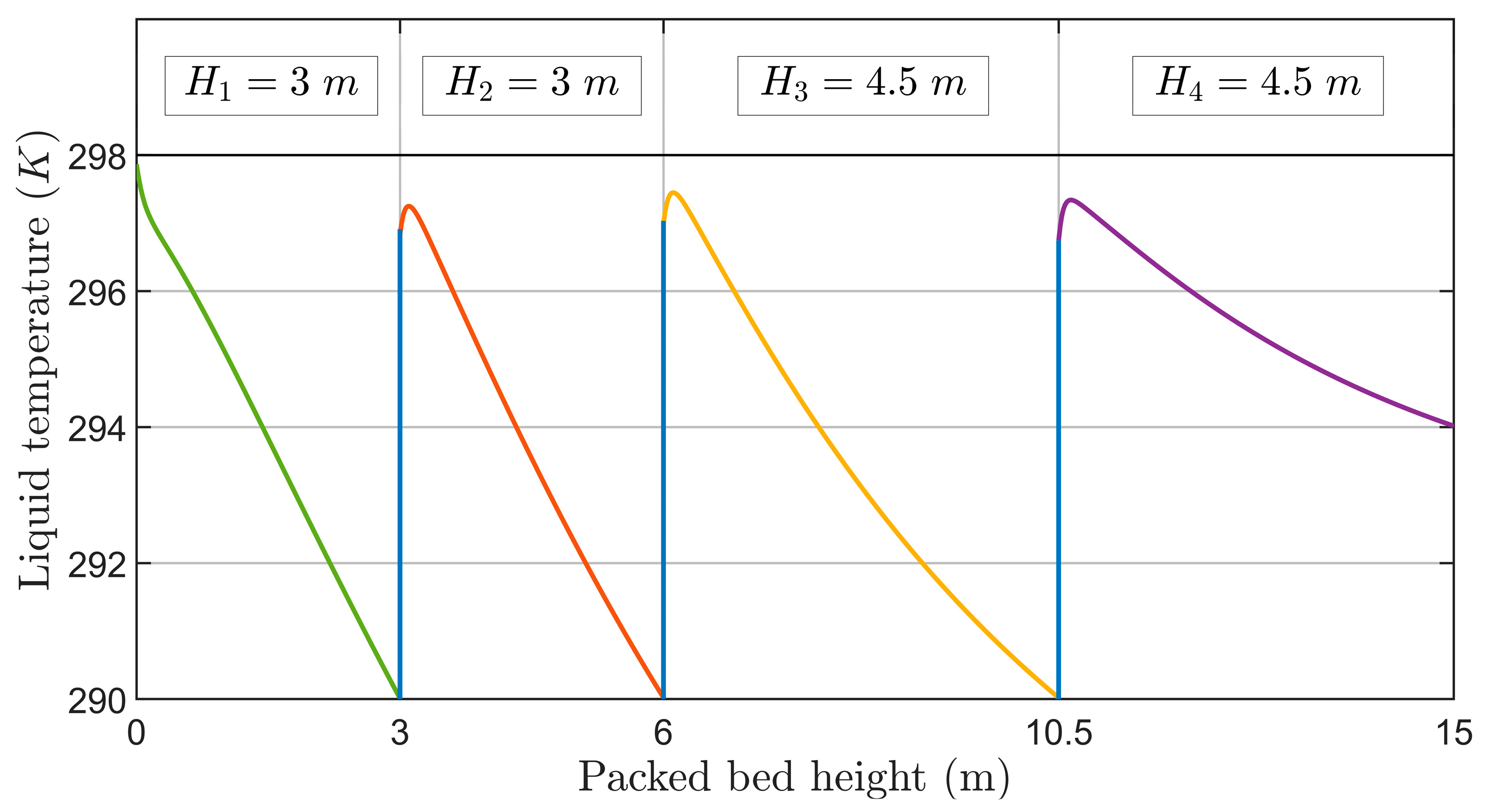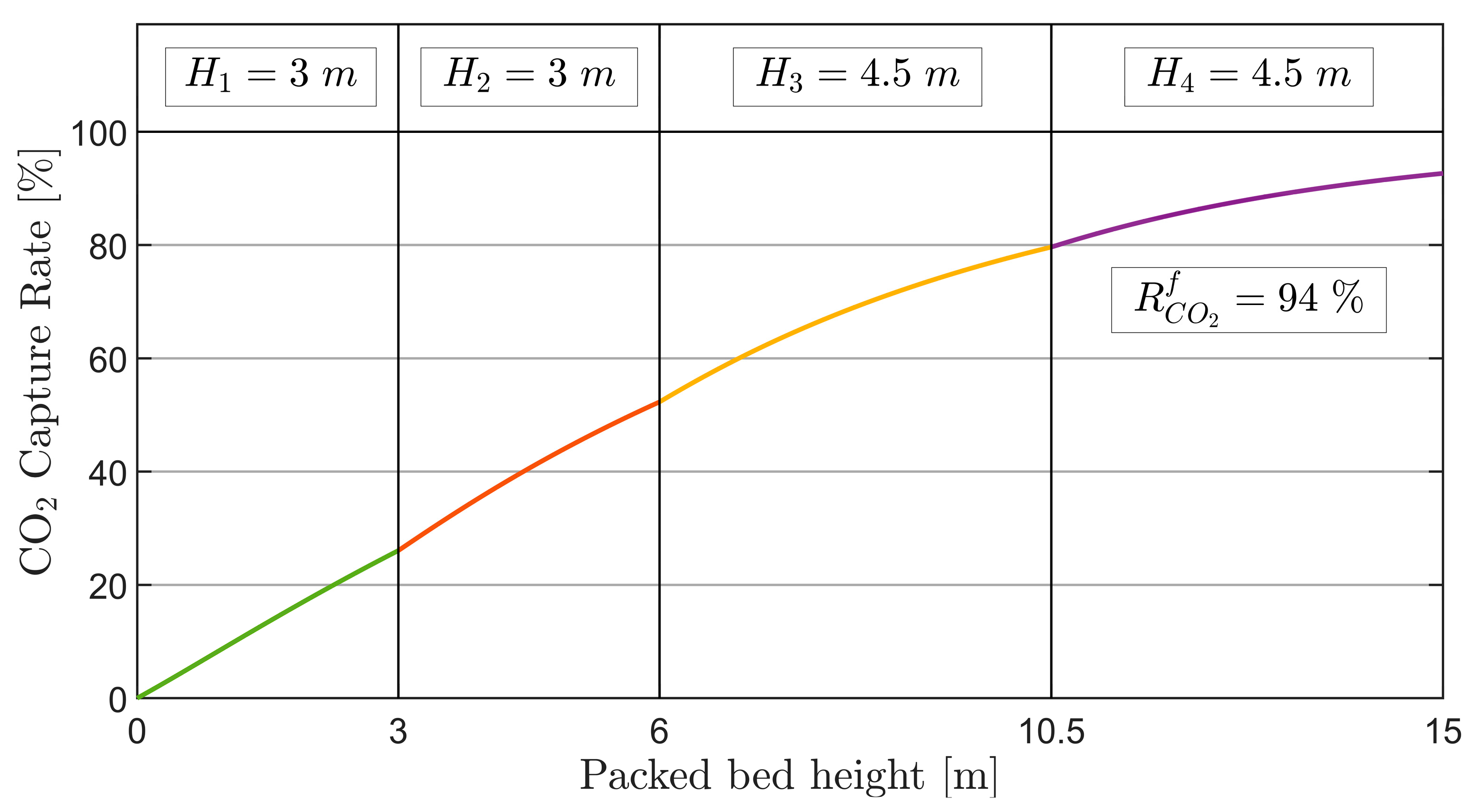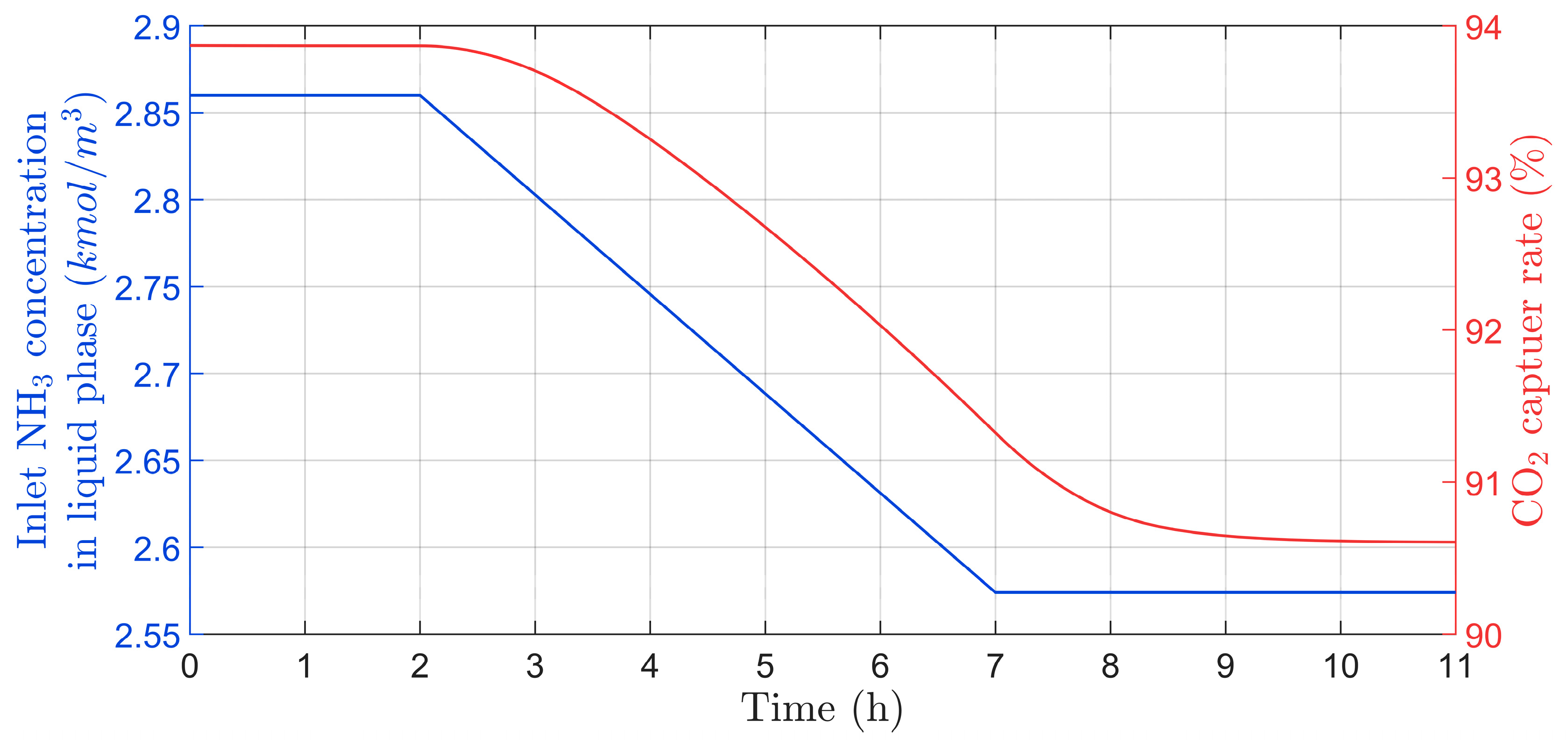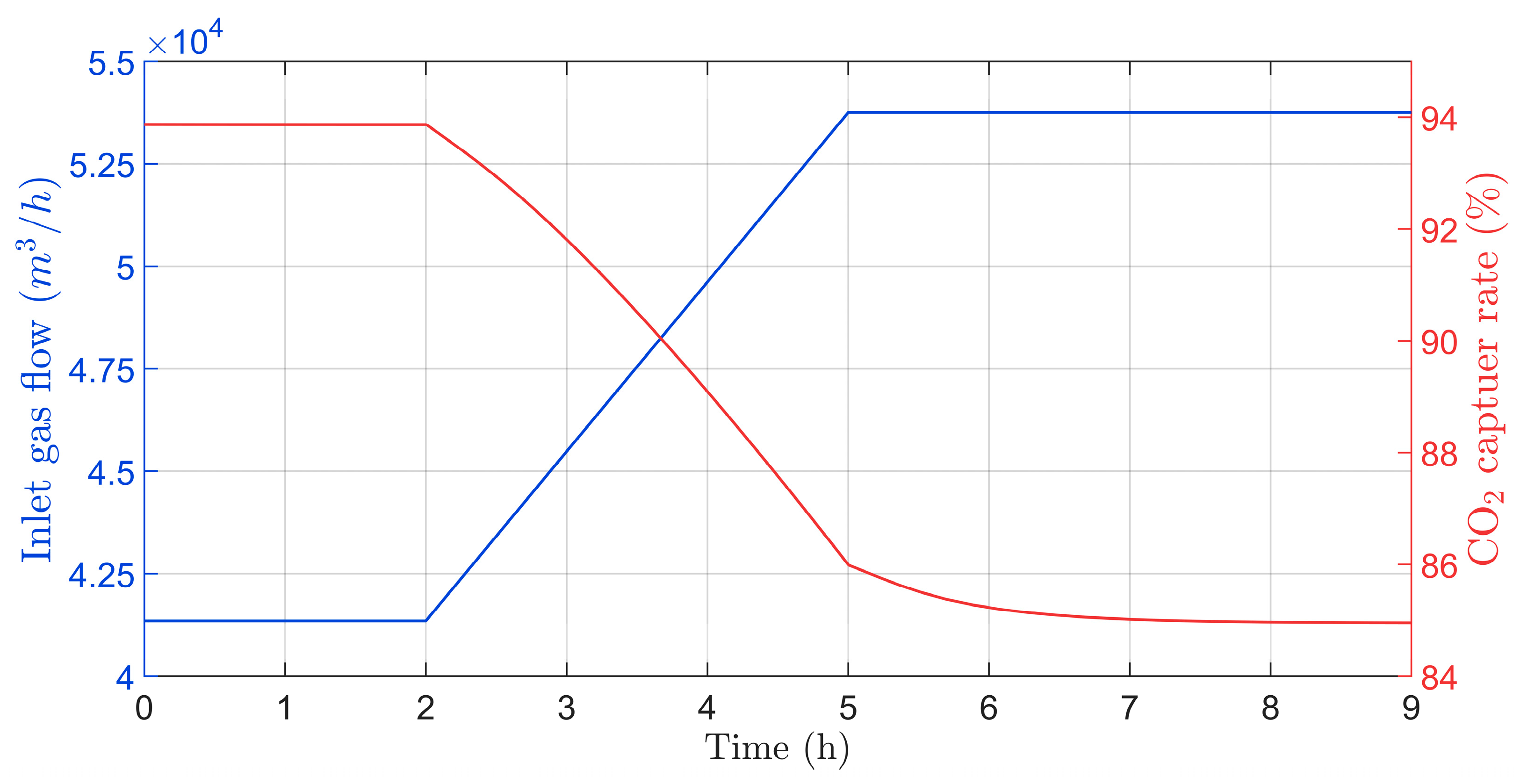1. Introduction
Over the last few years, global warming has become one of the biggest concerns worldwide, especially in the context of the ongoing United Nations’ mission, which contains a set of goals designed to be “a blueprint to achieve a better and more sustainable future for all people and the world by 2030”. It is connected to more than one of these objectives, being not only a cause for extreme climate changes, but also affecting earth and water life [
1]. Among the greenhouse effect gases, carbon dioxide is by far the most abundant, with CO
2 emissions being the driving force behind the global warming phenomenon [
2].
Despite the apparent recent decline in anthropogenic CO
2 emissions as a consequence of the global pandemic and containment measures, the demand for energy continues to increase with the growth of the world population and the development of the industrial sector [
3]. Furthermore, energy production through the burning of fossil fuels, which is still the most widely used energy source despite efforts to find renewable energy sources, remains at the top of global CO
2 emissions [
4].
Thus, researchers focus on developing and improving carbon capture methods that would significantly reduce emissions and thus press the breaks on the global warming phenomenon. There are several techniques currently available, with absorption being one of the most feasible due to its technical performance and increased gas treating capacity [
5,
6,
7,
8,
9].
Although being one of the most mature methods for CO
2 capture, the amine-based absorption process still has major disadvantages, such as: (i) forming irreversible degradation products (in the presence of SO
2 and O
2, implies the need to take a preceding step of SO
2 removal from the flue gas); (ii) high corrosive nature (that can be overcome by using corrosion inhibitors, but with higher costs of the process); and (iii) higher regeneration energy, the energy penalty being at least 10% net electricity [
7,
8,
10].
To overcome these drawbacks, recent research has considered the use of other solvents and the potential of optimizing already-developed techniques. Aqueous ammonia-based CO
2 absorption processes are one of the promising alternatives due to their numerous advantages: (i) low regeneration duty, due to the low CO
2 reaction enthalpy; (ii) commercially lower price; (iii) ability to remove most acid gases (SO
2, NO
x, HCl, HF); (iv) low environmental footprint; (v) low desorption temperature; (vi) the product (NH
4HCO
3) can be used as raw material or be desorbed to CO
2; and (vii) low corrosivity [
7,
8,
11,
12,
13].
Despite the aforementioned advantages, a major limitation of using ammonia solutions for CO
2 absorption that prevents their large-scale industrial application is the high volatility of NH
3. The loss of solvent leads to both limitations regarding its use and further environmental problems [
8,
11]. The ammonia slip in the absorption column can be controlled by adding an acid water wash or by operating the column at a low temperature that ranges below 293 K.
Hence, over the last few years, ammonia-based capture technologies have come back into researchers’ focus, relying not only on experimental procedures, but also on process modeling and techno-economical analysis to optimize and improve already-existing systems [
8,
11].
Four technologies are proposed in the literature for CO
2 capture using aqueous NH
3 solution: chilled NH
3 process, mild-temperature aqueous NH
3-based CO
2 capture, mixed-salts capture technology, and hollow-fiber membrane contactors [
14,
15].
The chilled NH
3 process (CAP) is a post-CO
2 capture technology that is achieved by direct contact of CO
2 from flue gases with an aqueous NH
3 solution at low temperatures (278–288 K). This CO
2 capture process has three main subsystems [
15]:
Flue Gas Cooling: the flue gas desulfurization (FGD) unit is typically 323–333 K; in this unit, the flue gas stream is cooled to condense water vapors and remove residual contaminants such as SO2, NOx, HCl, and sulfuric acid mist;
CO2 Absorption: CO2 absorption by direct contact with highly concentrated NH3 solution at low temperatures, producing a slurry containing ammonium bicarbonate and ammonium carbonate;
High-Pressure Regeneration: The CO2-rich slurry is pumped through a heat exchanger. When the ammonium bicarbonate dissolves and forms a clean solution (temperature above 353 K), the solution is injected into the stripper, and after the wash section a pure gas is obtained.
This technology, however, comes with several difficulties in handling solids, requiring the use of additional equipment, like the hydrocyclone.
Mild-temperature aqueous ammonia-based CO
2 capture is a post-combustion CO
2 capture technology that includes an integrated process for cooling the flue gas, an NH
3 recycle unit, an SO
2 removal unit, and a CO
2 capture unit. SO
2 from residual gas is re-moved into the pretreatment column. The absorption of CO
2 takes place in a two-stage absorber column, where the liquid CO
2-rich solution goes to the stripper, and the gas with vaporized NH
3 goes to the wash unit, where the NH
3 is recovered with the SO
2 previously removed, producing ammonium sulfite to be used for fertilizer production. In the stripper, the CO
2 is desorbed and the absorption solution is sent back to the absorption column [
14].
In the mixed-salts capture technology, the solvent is a liquid mixture of NH3 and K2CO3. It is based on the advantages of each absorbent, which leads to improved reaction kinetics, and reduced NH3 emissions. Both substances can capture CO2; therefore, chemical absorption is a combination of reactions between CO2 and NH3/K2CO3. The particular characteristic of the mixed-salt solvent is that NH3 works as a promoter or catalyst for the CO2 capture process and K2CO3 helps reduce ammonia release in the absorber. The CO2 absorption process takes place at ambient temperature.
The absorption system consists two absorbers that operate in series. The flue gas from the FGD process is cooled to 293–313 K before the absorption process. The first stage of absorption takes place in absorber 1, where an NH3-rich solution captures most of the CO2, up to 80%. The second stage of absorption takes place in absorber 2, where a K2CO3-rich solution recovers the largest amount of NH3 and forms a limited quantity of CO2.
After the absorption, the CO
2-rich solution is introduced to the top of the desorber, where the absorption solvents are regenerated, and after the condensation of water and NH
3, a pure CO
2 flux is obtained [
14].
Hollow-fiber membranes have been used in order to improve aqueous NH
3-based capture technologies, by reducing NH
3 loss in the absorption process. The two phases do not come into direct contact; each phase flows on one side of the membrane. In order to be absorbed, CO
2 from the gas phase diffuses through the membrane pores into the liquid phase. The membrane can reduce ammonia losses, but it cannot eliminate them. Gaseous NH
3 can also diffuse from the liquid to the gas phase through the membrane. A drawback of the system is the decrease in absorption performance because of the membrane wetting over time [
14].
Ammonia-based CO
2 capture requires additional units to lower the concentration of NH
3 in the CO
2-depleted gas flow exiting the absorber. Even though the quantity of ammonia released through carbon capture units can reach values of thousands of ppm, the recommended maximum concentration by the limits imposed for existing ammonia-producing facilities within the EU is between 10 ppm and 40 ppm. This concentration can be achieved by operating the absorption column at lower temperatures and by washing the outlet gas flow with water [
16,
17].
For the previously described processes, several models are presented in the literature, both rate-based and steady-state, based on the electrolyte-NRTL (non-random two-liquid) method. These models are mostly implemented in Aspen Plus software for simulation and describe the absorption kinetics, the solvent loss, the vapor-liquid equilibrium, and the absorption heat [
18,
19,
20,
21,
22,
23,
24]. Considering the dynamic evolution of the absorption process of CO
2, these models are not able to describe the variation in time of the process parameters. Atzori et al. (2023) developed a dynamic mathematical model for CO
2 absorption in aqueous ammonia solution, but only at a laboratory scale [
25].
This study presents a comprehensive and intricate mathematical model that provides valuable insights into the process of carbon dioxide capture using ammonia aqueous solutions as solvents. The model is able to describe the mass transfer between the two phases, the chemical absorption of CO2, H2O, and NH3 evaporation, and also the temperature variation. The ability of the model to accurately describe the process under consideration is supported by the validation results. Specifically, the validation process involves the examination of four parameters over the height of the absorption column. As a novelty, this work presents an exhaustive scaled-up dynamic mathematical model for the absorption process of CO2 using NH3 solution, at an industrial level. Furthermore, considering the primary drawback of the system, the high volatility of ammonia, we propose to extend the validated dynamical model to an intercooled absorber in order to reduce the vaporization of the solvent, thus increasing the overall efficiency of the CO2 absorption process.
2. Methods
A schematic flow diagram of a baseline CO
2 capture unit using ammonia solution at ambient temperature is presented in
Figure 1.
According to the flowsheet diagram, the flue gas rich in CO
2 is directed to a pre-treatment column to remove SO
2 and NO
x, while simultaneously cooling the gas. The pre-treated flue gas flows into the chemical absorption column, where the carbon dioxide reacts with the ammonia solution by countercurrent contact. The gas leaving the absorber enters a wash column to remove the NH
3, and the clean gas is discharged into the atmosphere. The ammonia solution rich in carbon dioxide flows into the desorption column, where the CO
2 is released. The recovered solvent is cooled by a heat exchanger and flows back to the absorption column. The operating conditions for absorption: ammonia concentration < 7 wt%, temperature of inlet gas ∼283 K, CO
2 inlet concentration 10–15% (at 105 kPa), and liquid inlet temperature 283–303 K. The desorption process takes place at high pressure of 300–850 kPa and temperatures between 363 K and 423 K. The wash column can be connected to the pre-treatment column. The water is circulated between the two columns, and the NH
3 from the wash water column helps with the removal of acidic components (SO
2 and NO
x) from flue gas in the pre-treatment columns [
26]. SO
2 absorption efficiency is around 95%, due to the increase of SO
2 solubility in the water in the presence of NH
3. The flue gas contains mainly nitric oxide, which does not react with ammonia and has low water solubility. For NO elimination from the flue gas, an additional unit is necessary for the oxidation of nitrogen oxide to nitrogen dioxide, which is highly soluble in water [
24]. The outlet CO
2 concentration is over 99%, and the CO
2 removal efficiency is up to 85%.
The power plant is operated consistently with the grid demand (in a dynamic way), at entire capacity during the day and partial-loading or shut down in the middle of the night [
18] (
Figure 2). Using renewable energy sources such as solar and wind leads to the intensification of time-irregular operation scenarios. The operation of the CO
2 capture units would be strongly influenced by load-following exploitation of the power block [
27]. For a successful implementation of carbon capture processes on an industrial scale, flexible, dynamic operation is crucial, as continuous full-time CO
2 capture is not achievable. In order to optimize the operation procedure, dynamic mathematical modeling and simulation become practical tools.
The modeling of the process is based on experimental results and parameters from the Munmorah power station in Australia [
28]; data published by Yu et al., 2011 [
24].
The developed and validated model was scaled-up in order to simulate the absorption process of CO2 on an aqueous ammonia solution at an industrial scale, using a column with intercooling after each layer of packing material.
Absorption with Intercooling
The reaction between ammonia (NH3) and carbon dioxide (CO2) is exothermal, making the temperature of the liquid phase rise during the absorption process, which leads to an increase in the rate of ammonia evaporation, which has a negative impact on the environment and the efficiency of CO2 capture. In order to minimize ammonia loss through vaporization, and increase CO2 absorption rate, an absorption column with intercooling between the stages is proposed in this work.
The absorption column is equipped with four layers of random packing material. The liquid solution is extracted after each layer and cooled before being introduced at the top of the next layer of packing material. This process reduces the temperature of the liquid phase and consequently decreases the rate of ammonia evaporation [
29]. The cooling process also enhances the efficiency of CO
2 capture.
The intercooling method provides multiple benefits. First, it minimizes the loss of ammonia due to vaporization, which is environmentally harmful and decreases the efficiency of the CO
2 capture process. Secondly, it reduces the size of the washing section for the purified gas, making the process more economically and technically efficient. A schematic diagram of the absorption column with intercooling is depicted in
Figure 3.
3. Dynamic Mathematical Modeling of CO2 Absorption in Ammonia Solutions
The absorption of carbon dioxide in an ammonia solution can be modeled using the two-film theory, which considers several processes, including CO
2 gas phase transport, diffusion of CO
2 through the gas-liquid interface, CO
2 liquid phase transport, and the chemical reaction in the liquid phase. Due to the temperature variation and different concentrations in the two phases over the column height, the water and ammonia from the liquid phase vaporize through the gas-liquid interface (
Figure 4). In addition, convective transport in both the gas and liquid phases and the temperature variation during the absorption process must be taken into account for an accurate mathematical model.
To develop this model, several assumptions have been made, including:
The fluid mechanics is described by the plug flow model;
The system is assumed to be well-mixed, meaning that there is no concentration gradient within the gas or liquid phases;
The solubility of CO2 is described by Henry’s law;
The chemical reaction only takes place in the liquid phase.
These assumptions allow for the development of the mathematical model that describes the absorption of CO2 in an aqueous ammonia solution, which can be used to optimize the process and improve its efficiency.
3.1. Chemical Reaction
The carbon dioxide chemical absorption in aqueous ammonia could be described by the following equilibrium reactions [
30]:
Considering the complexity of the mechanism and the large number of possible reactions, to determine the reaction constant
k, the following global equation was considered (second order, irreversible):
The absorption of carbon dioxide can occur with or without the appearance of a solid phase, since the salt’s solubility depends on the temperature of the process. The NH4HCO3 solubility at 293 K is: 320 g/L for carbonate, 790 g/L for carbamate, and 220 g/L for bicarbonate. Ammonium bicarbonate has the lowest solubility, and it can occur in the solid phase at a process temperature of 273–283 K. All formed salts remain in the solution at temperatures of 288–313 K.
Based on the global reaction equation, the reaction rate is
, where the kinetic constants (pre-exponential factor and activation energy) are presented in
Table 1.
3.2. Mass Transfer Models
The carbon dioxide molar flow is determined using the equation [
32]:
where:
The partial mass-transfer coefficients were calculated using Billet and Schultes (1999) [
33] correlations for unstructured packing columns:
where:
The liquid holdup is calculated by the following formula:
The effective mass-transfer area,
ae, is calculated according to the value of the Reynolds’ number using one of the equations described below [
33]:
The absorption of CO
2 in ammonia solution is described by an intermediary kinetic regime (0.3
< Ha < 5); therefore, the enhancement factor (
E) according to the Whitman model is
[
25].
The global mass transfer coefficients for carbon dioxide
Kg and
Kl are calculated by:
The water and ammonia volatilities:
For the water flow transferred trough G/L interface, the global mass transfer coefficient is numerically equal to the gas resistance, and the liquid side resistance is neglected. The gas side resistance for water is calculated using a correlation proposed by Billet and Schultes (1999) [
33].
3.3. Balance Equations
The main equations used in the mathematical model are derived from the total and component mass balances, and energy balances for both the gas and liquid phases.
The total mass balance for the liquid and gas phases:
The components mass balance for the liquid/gas phase:
The energy balance for the liquid and gas phase:
i—component, j—phase
only for liquid phase
The CO
2 absorption efficiency (CO
2 capture rate) is calculated with the following equation:
The mathematical model also contains algebraic equations that are used to calculate the chemical-physical properties (CO
2 solubility in ammonia solution, densities, diffusion coefficients, viscosities, heat capacities, etc.). The physico-chemical properties calculations are shown in
Table 2.
4. Simulation Results
The partial differential equations of the mathematical model were transformed by numerical discretization into ordinary differential ones, and were implemented in Matlab/Simulink; a diagram of the algorithm used is presented in
Figure 5. The absorber operating data used for solving the mathematical model is given in
Table 3.
In order to model the absorption of CO2 in an ammonia solution and analyze the behavior of the system over time, a two-step process is used. Firstly, the balance equations are solved in steady state. The column height is divided into n equal sections with a thickness of dz, allowing for the calculation of steady-state profiles for flow rates, concentrations, and temperatures along the height of the column. This provides a snapshot of the system at a given moment in time, and is used as the initial condition for the dynamic simulation. In the second step, a dynamic simulation is performed. At each time iteration, flow rates, concentrations, and temperature profiles are calculated along the height of the column based on the initial conditions obtained from the steady-state simulation. The dynamic simulation takes into account the changes in the system over time due to the absorption of CO2, and as a result, produces a time series of profiles for each variable in the system.
When the simulation time (tsim) is reached, a time and space profile for each variable in the system is obtained. This provides a complete picture of how the system behaves over time, and allows for the analysis of key performance indicators such as CO2 capture efficiency, ammonia loss due to vaporization, and energy consumption. The results of the simulation can be used to optimize the design and operating conditions of the absorption column, leading to improved efficiency and reduced environmental impact.
4.1. Steady-State Profiles
The figures depict profiles of concentration, flow, and temperature for the gas phase along the height of the packing material in the pilot absorption column. These profiles provide valuable insights into the behavior of the gas phase as it interacts with the ammonia solution during the absorption process.
Figure 6 shows the profile of the gas flow rate and CO
2 concentration along the height of the packed bed in the absorption column. It is observed that both the gas flow rate and CO
2 concentration decrease over the height of the packed bed, which is expected in a gas-liquid absorption process. This is because as the gas flows through the packed bed, it comes into contact with the liquid phase and some of the CO
2 is absorbed by the liquid, resulting in a decrease in the CO
2 concentration in the gas phase.
Figure 7 shows the profiles of liquid and gas concentrations of ammonia along the height of the packed bed. Ammonia is a volatile compound, and its loss due to vaporization is a common problem in gas-liquid absorption processes. The results show that as the packed bed height increases (from bottom to top), the liquid concentration of NH
3 increases, as does its gas concentration. The gas concentration increases steadily, and after peaking at a value of about 4.8 × 10
−4 M, decreases slightly to a value that remains almost constant for the top half of the column.
Based on the results obtained from both experiments and simulations, it is clear that the inlet temperature of the liquid flow plays a crucial role in the absorption process. Further investigation into this parameter can be useful in order to better understand its impact on both the carbon capture rate and the loss of ammonia due to vaporization.
Figure 8 presents the influence of liquid temperature on the NH
3 evaporation process. As shown in the figure, an increase in temperature leads to an increase in the concentration of NH
3 in the gas phase. This can lead to disadvantages in terms of system performance. Therefore, it is important to carefully consider the impact of the initial temperature of the liquid flow on the overall efficiency of the absorption process, taking into account both the benefits and drawbacks associated with it.
4.2. Model Validation
The mathematical model described in
Section 3 of this paper was validated using experimental data from the pilot plant at the Munmorah black coal-fired power plant station in Australia, published in the literature by Yu et al., 2011, 2015 [
24,
38].
The considered parameters were monitored across the height of the absorption column and the obtained results for both the pilot plant and the model are presented in the following figures.
The parameters considered are the ones that had an important influence on the system’s overall performance: the liquid and gas phases’ temperatures, the absorption rate, and the NH
3 concentration in the gas phase. As shown in the figures below, the model replicates rather accurately the path outlined by the experimental data (
Figure 9 and
Figure 10).
Moreover, in
Figure 11, the validation in terms of CO
2 outlet concentration in the gas phase is shown. For this case, a value of R = 0.8967 was obtained, showing that for instances in which the inlet temperature of the solvent is closer to the ambient temperature, the model gives better results.
4.3. Dynamic Simulation Results and Discussions
To be able to better assess how the system reaches a new steady state, and how it behaves under a constant increase in the flue gas flow, the scenario from
Figure 12 was proposed. As shown, an increase and decrease in the inlet gas flow of 25% were considered. The results show the shift between the initial steady state (the red line, at
t = 0 h) and the new steady state (the blue line, at
t = 8.10 h). The increase/decrease starts at
t = 5 h and stops at
t = 8 h.
The new steady state that is connected to the higher value of the gas flow is set at a higher value of CO
2 concentration in the gas phase (
Figure 13). Hence, a decrease in the capture rate of about 7% of the initial value is obtained. If the decrease in the inlet gas flow of 25% is considered, the gas phase carbon dioxide concentration is decreased, which translates into an increase in the carbon capture rate of about 10% compared to the initial value (
Figure 14).
The system’s ability to adapt to changes in gas flow rate was studied by considering a scenario where the gas flow rate varied over a 24-h period. This variation was designed to replicate the changes in energy demand that occur during a typical day, and a 25% increase in gas flow rate was considered. To visualize this scenario, a 55-h period was analyzed, including two full 24-h cycles. The energy demand data used to create the scenario was adapted from the literature and was only intended to demonstrate the major steps, not the small fluctuations that would be present in a real-world situation [
5].
The response of the system to the gas flow rate variation was evaluated in terms of the carbon capture rate and the concentration of NH
3 in the gas phase. The results showed that the system was able to adapt quickly and effectively to the changes in gas flow rate, with no significant delay (
Figure 15). The new steady state was achieved within minutes after the gas flow rate reached the new value. Overall, the system demonstrated good flexibility and adaptability to changing operating conditions, which is an important characteristic for practical applications.
4.4. Simulation Results of Absorption with Intercooling
The study involved scaling up the validated mathematical model to simulate the CO
2 absorption process in an aqueous ammonia solution at an industrial scale using a specific column design. The column design used random packing material with intercooling after each layer, and the liquid phase was cooled to 290 K after each layer of packing material. The cooling process aimed to minimize the loss of ammonia due to vaporization and enhance the rate of CO
2 absorption.
Table 4 presents the specific characteristics of the absorption column, including its dimensions and the operating conditions employed in the simulation.
The liquid temperature profiles shown in
Figure 16 indicate that the temperature of the liquid absorbent increases gradually as it moves down the column due to the heat generated by the absorption process. The liquid absorbent enters the column at the top (H = 15 m), with a temperature of 294 K. Due to the heat generated by the absorption process, the liquid solution temperature increases to 297 K after the 4th layer of packing (H
4 = 4.5 m). To prevent ammonia loss due to vaporization, the liquid solution is cooled to 290 K after each layer of packing material. This cooling process results in a stepwise decrease in the liquid temperature as it moves down the column. At the base of the absorption column (H = 0 m), the liquid solution exits the process at 298 K.
In
Figure 17, the CO
2 capture rate is shown over the height of the column for the industrial-scale simulation.
The gas enters the absorption column at the base of the first packing layer (H = 0 m). At the top of the column (H = 15 m), due to the absorption process of CO2, the capture rate reaches values of about 94%.
In the absorption process of CO
2 using an aqueous ammonia solution, the ammonia vaporization is a major problem, not only because of its harmful effect on the environment, but also because of the decreased efficiency of the capture process over time. By using an absorption column with intercooling between the packed bed layers, minimizing the temperature inside of the column, the concentration of ammonia in the clean gases obtained at the top of the column is under 10 ppm. The time-variation of this concentration is shown in
Figure 18.
To observe the system’s response due to the vaporization of ammonia over time, it was considered a decrease of 10% of the inlet concentration of NH
3 in the liquid phase during a period of 5 h (
Figure 18—blue line). The CO
2 capture rate decreases in time (
Figure 18—red line), from a value of almost 94% to 90.6%. The new steady-state profile is obtained in 3 h after the inlet concentration of ammonia in the liquid phase has been stabilized (at
t = 7 h) due to the inertia of the system. The implications of considering an increase of the inlet flue gas flow of 30% over a period of time of 3 h are shown in
Figure 19.
The absorption efficiency decreases in time, from 94% to about 85%, due to the increase in the flue gas flow, which leads to a decrease in the residence time of the gaseous phase in the absorption column. The new steady state is achieved after about 2.5 h, after the inlet gas flow reaches the new steady value (t = 5 h).
5. Conclusions
The presented work offers a comprehensive and complex mathematical model that describes carbon dioxide capture using ammonia aqueous solutions as solvents. The model has been validated using experimental data, and is capable of describing the considered process with high accuracy. Notably, the validation was conducted not only in terms of one parameter, but four, profiling them over the absorption column height. The validation results showed a good correlation between the simulated and experimental data, with an error coefficient over R = 0.91, and profiles following the trendline of the experimental values.
Furthermore, the developed and validated model was scaled-up to simulate the absorption process of CO2 in an aqueous ammonia solution on an industrial scale, using a column with intercooling after each layer of packing. The simulation results of the absorption column with intercooling showed that by minimizing the temperature inside of the column, the concentration of ammonia in the clean gases obtained at the top of the column is under 10 ppm, and the capture rate increase is up to 94%. This demonstrates the effectiveness of the intercooling approach in minimizing solvent loss through vaporization, and maximizing the absorption rate of CO2.
In addition, the analysis of a predefined scenario showed that the model can reproduce the system’s behavior under different conditions. For instance, the system’s response to the variation by 25% of the influent flue gas flow showed a significant variation in the carbon capture rate (7–10%) for both cases considered, an increase and a decrease, respectively. The response to the vaporization of ammonia in time, which was considered by decreasing the inlet concentration of NH3 in the liquid phase by 10% over a period of 5 h, resulted in a decrease in the CO2 capture rate from almost 94% to 90.6%, translating into a decrease of 3.4%. It took about 3 h to reach a new steady-state profile after the inlet concentration of ammonia in the liquid phase stabilized (at t = 7 h), due to the inertia of the system.
Overall, the presented model can be useful for further applications, such as process optimization and control techniques, which would diminish the disadvantages mentioned previously, such as solvent loss through vaporization.
